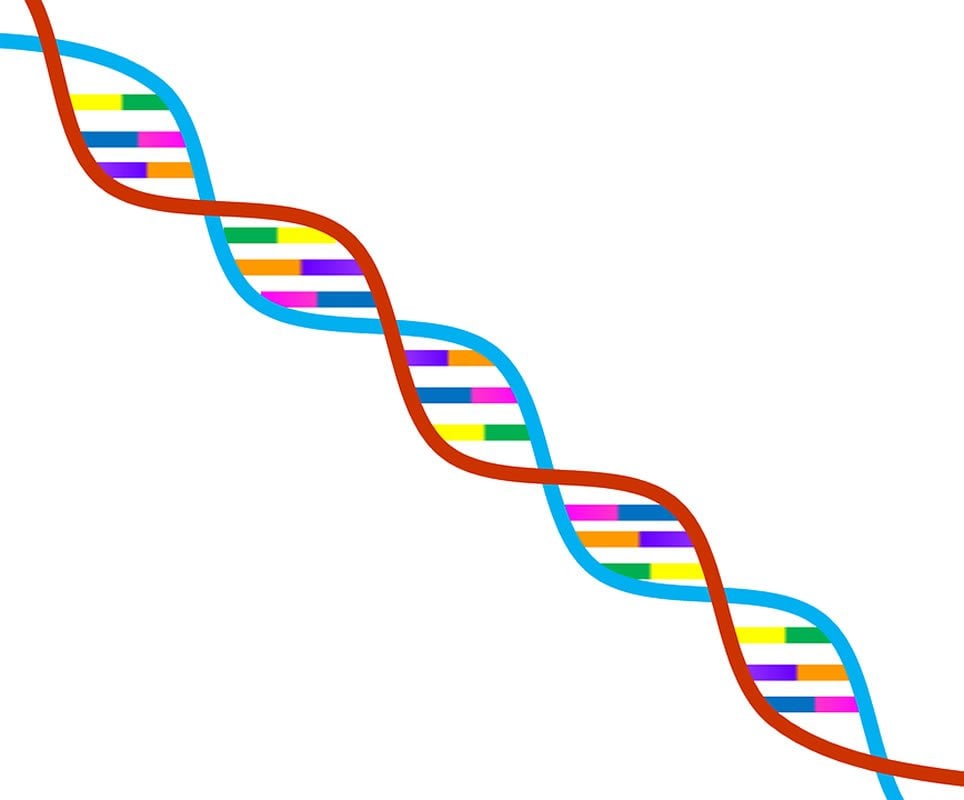Summary: Researchers report up to 25% of same-sex behaviors are associated with genetic variants. The study identified five new genes associated with sexual behavior. They report there is no one single gene linked to same-sex sexual behavior or orientation, but numerous genes, as well as other factors which contribute. Researchers emphasize the markers may be unreliable in predicting same-sex behavior but may influence the likelihood for specific relationship choices.
Source: Science
According to the largest ever study on the genetics of sexual behavior, those who have same-sex partners are more likely to have specific DNA markers. Researchers say it is possible that thousands of genes, each with a small effect, can influence sexual preference.
Published today in Science, the paper is perhaps the most solid data to date linking genetics to same-sex behaviors. The researchers emphasize the markers may be unreliable in predicting sexual behavior. However, the findings provide evidence that some genes do influence the likelihood of same-sex attractions and relationship choices.
Examining genetic markers and survey data about sexual behavior from almost 500,000 people, the researcher identified five new genetic variants not previously associated with homosexuality. These variants were most common in those who reported being in at least one same-sex relationship. Two of the markers were shared between men and women; two were exclusive to males and one exclusive to females. However, the newly identified markers accounted for less than 1% of same-sex behavior.
One of the variants identified in males was associated with male patent baldness, suggesting a tie to testosterone.
When all of the variants were combined across the genome, researchers estimated genetics can account for between 8-25% of non-heterosexual behavior. Other contributing factors may be environmental influences, in-utero hormonal exposure or social influence later in life.
Previous research linked these biomarkers with a person’s openness to new experiences and increased risks of depression.
Researchers say the findings are limited because people who had a single same-sex experience were counted as non-heterosexual. They caution experimenting with a same-sex partner may reflect a person’s openness to new experiences rather than actual sexual orientation. Also noted is the data from the UK Biobank did not include details on sexual attraction, just sexual behavior.

The main limitation of the study is that the focus was on sexual behavior, not orientation or identity. Additionally, the cohort group consisted of only those with European ancestry. As such, it is not known whether similar results would be seen across different ethnic groups.
In conclusion, researchers say there is no one single “gay gene”, but numerous genes contributing to sexual behavior.
The study was conducted by an international group of researchers. The data was provided by the UK Biobank and 23andMe.
Source:
AAAS
Media Contacts:
Press Office – AAAS
Image Source:
The image is in the public domain.
Original Research: Open access
“Large-scale GWAS reveals insights into the genetic architecture of same-sex sexual behavior”. Andrea Ganna et al.
Science. doi:10.1126/science.aat7693
Abstract
A New Perspective on Visual Perspective in Memory
INTRODUCTION
Across human societies and in both sexes, some 2 to 10% of individuals report engaging in sex with same-sex partners, either exclusively or in addition to sex with opposite-sex partners. Twin and family studies have shown that same-sex sexual behavior is partly genetically influenced, but previous searches for the specific genes involved have been underpowered to detect effect sizes realistic for complex traits.
RATIONALE
For the first time, new large-scale datasets afford sufficient statistical power to identify genetic variants associated with same-sex sexual behavior (ever versus never had a same-sex partner), estimate the proportion of variation in the trait accounted for by all variants in aggregate, estimate the genetic correlation of same-sex sexual behavior with other traits, and probe the biology and complexity of the trait. To these ends, we performed genome-wide association discovery analyses on 477,522 individuals from the United Kingdom and United States, replication analyses in 15,142 individuals from the United States and Sweden, and follow-up analyses using different aspects of sexual preference.
RESULTS
In the discovery samples (UK Biobank and 23andMe), five autosomal loci were significantly associated with same-sex sexual behavior. Follow-up of these loci suggested links to biological pathways that involve sex hormone regulation and olfaction. Three of the loci were significant in a meta-analysis of smaller, independent replication samples. Although only a few loci passed the stringent statistical corrections for genome-wide multiple testing and were replicated in other samples, our analyses show that many loci underlie same-sex sexual behavior in both sexes. In aggregate, all tested genetic variants accounted for 8 to 25% of variation in male and female same-sex sexual behavior, and the genetic influences were positively but imperfectly correlated between the sexes [genetic correlation coefficient (rg)= 0.63; 95% confidence intervals, 0.48 to 0.78]. These aggregate genetic influences partly overlapped with those on a variety of other traits, including externalizing behaviors such as smoking, cannabis use, risk-taking, and the personality trait “openness to experience.” Additional analyses suggested that sexual behavior, attraction, identity, and fantasies are influenced by a similar set of genetic variants (rg > 0.83); however, the genetic effects that differentiate heterosexual from same-sex sexual behavior are not the same as those that differ among nonheterosexuals with lower versus higher proportions of same-sex partners, which suggests that there is no single continuum from opposite-sex to same-sex preference.
CONCLUSION
Same-sex sexual behavior is influenced by not one or a few genes but many. Overlap with genetic influences on other traits provides insights into the underlying biology of same-sex sexual behavior, and analysis of different aspects of sexual preference underscore its complexity and call into question the validity of bipolar continuum measures such as the Kinsey scale. Nevertheless, many uncertainties remain to be explored, including how sociocultural influences on sexual preference might interact with genetic influences. To help communicate our study to the broader public, we organized workshops in which representatives of the public, activists, and researchers discussed the rationale, results, and implications of our study.






